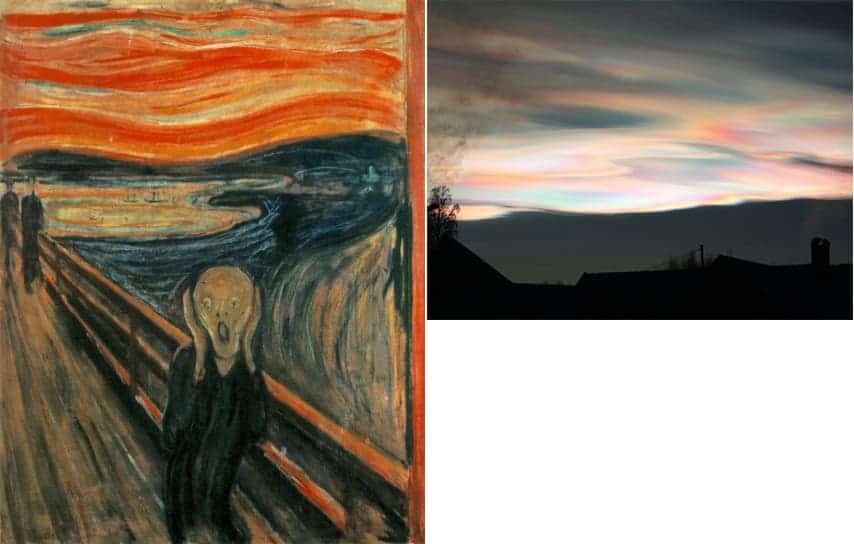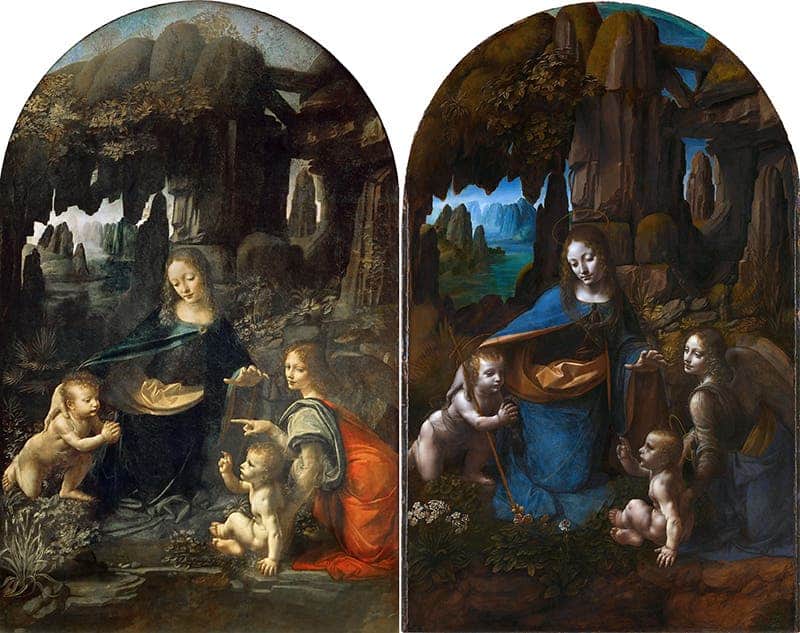Two exciting papers presented this week at the European Geosciences Union (EGU) in Vienna, Austria could settle the debate around two of the world’s most famous paintings. The researchers argue The Scream by Edvard Munch was inspired by a rare type of cloud and that a geological analysis suggests The Virgin of the Rocks on display in the National Gallery in London can not be attributed to Leonardo da Vinci.
The scream

Munch’s 19th-century masterpiece The Scream is one of the most recognizable paintings in the world. It’s been featured countless times in pop culture with various renditions appearing in film, literature, art, and animation. But no one really knows what inspired Munch to paint that incredible orange-red sky. The pet-favorite theory is that the volcanic eruption of Krakatoa in 1883 which caused the European sky to shine in fiery hues is what ultimately influenced Munch when he completed the painting in 1893. Others have suggested that Munch was inspired by the proximity of a madhouse and a slaughterhouse to the artwork’s subject’s supposed Oslo location.
Helene Muri of the Department of Geosciences of the University of Oslo has a different take on the matter. She claims that despite the fact that Krakatoa’s eruption in Indonesia caused colorful sunrises and sunsets, the injected particles in the stratosphere couldn’t have produced the wavy textures seen in the famous painting. Instead, she identified a natural phenomenon that much better resembles Munch’s distorted sky. Namely, polar stratospheric clouds, also called nacreous or mother-of-pearl clouds.
These rare clouds form when stormy weather causes moist air to bang up against mountainsides and pushed up into the stratosphere where it condenses into ice crystals. These crystals are too thin to be seen with the naked eye during the day, but when the sunset shines from below, the crystals suspended in the clouds display the exact color and texture that Munch featured in his opus. According to Muri, mother-of-pearl clouds appear only four times a year.
da Vinci’s rocks

Elsewhere, Ann Pizzorusso, an independent scholar who is both a geologist and an expert on the Italian Renaissance, is showcasing new insight into one of the biggest controversies in art. There are two almost identical (to the untrained eye) paintings called Virgin of the Rocks housed in two separate museums, one in London, the other at the Louvre in Paris. The public knows of fewer than 20 paintings completed by the great Italian artist, inventor, and polymath. Why on earth would he complete two versions of the same painting? It’s a question that has inspired many controversial theories.
The story of the Virgin of the Rocks starts in 1483, when da Vinci, aged 30, arrived in Milan from Florence. He had already garnered a formidable reputation by then but was a bit in a financial mess so he accepted to paint the fantasy scene as an altarpiece for the Confraternity of the Immaculate Conception in their chapel at San Francesco Grande. It’s likely excursions to nearby caves, which da Vinci often enjoyed, served as inspiration for the work. He once wrote in a 1480 journal entry:
“Drawn by my eager desire I wandered some way among gloomy rocks, coming to the entrance of a great cavern, in front of which I stood for some time, stupefied and uncomprehending such a thing… Suddenly two things arose in me, fear and desire: fear of the menacing darkness of the cavern; desire to see if there was any marvellous thing within.”
Da Vinci never worked fast. This was a man who was equally skilled at painting as he was at anatomy and other sciences. All the rocks were drawn with maximum care and precision, as were the various plants showcased. Yet, some 21 years later, da Vinci painted the same painting again — almost the same painting. This later version is more idealized and the angel Uriel is no longer pointing at St John.
The controversy surrounding the Virgin of the Rocks has attracted some of the wildest opinions. Writers John Ruskin and Walter Pater claimed the painting is evidence of Leonardo’s decadence and his alleged homosexual proclivities, as the pointing angel was seen by them as a disturbingly androgynous figure. Dan Brown, author of The Da Vinci Code, wrote the Louvre picture is a secret allegory of Leonardo’s contempt for the established church, as it shows a Madonna-Christ pagan role-reversal.
Pizzorusso has been following the story of da Vinci’s controversial work for more than 20 years and even wrote a popular geology book on the subject called Tweeting Da Vinci. She notes that the plants and rocks featured in the painting housed at the London museum couldn’t have been made by da Vinci’s hand. She told EOS that on the Louvre version “you can see fossil imprints on the front of the sandstone and geologic features that would have been caused by sedimentation.” She also reiterated what other biologists have mentioned before, namely that the plants in the National Gallery painting don’t exist in nature whereas those housed at Louvre are real, like Iris germanicus.
“The plants are correct in the Louvre version, Iris germanicus, for example. And they are growing in the soft, sandy soil, whereas a lot of the plants in the London version are trying to grow out of hard diabase, where it’s very hard for roots to take hold,” she told science journalist Bas den Hond.
Simply put, the latter version shares nothing of da Vinci’s eye for drawing nature as closely as possible to reality.
“Basically, the rocks are unidentifiable,” she added. “You cannot tell whether they are sandstone or limestone. It almost looks like a stage setting, with Styrofoam rocks.”
Pizzorusso thinks the later version, now in London, was made by one of da Vinci’s coworkers, a fellow called Giovanni Ambrogio de Predis. She argues that da Vinci sold the Louvre painting to someone else, and the London painting was the fulfillment of his contract. Pressed by time, da Vinci likely accepted that his coworkers take care of the piece after his example.
The truth for both The Scream and the Virgin of the Rocks might never be known but it’s amazing what kind of evidence science is able to glean many centuries later.






